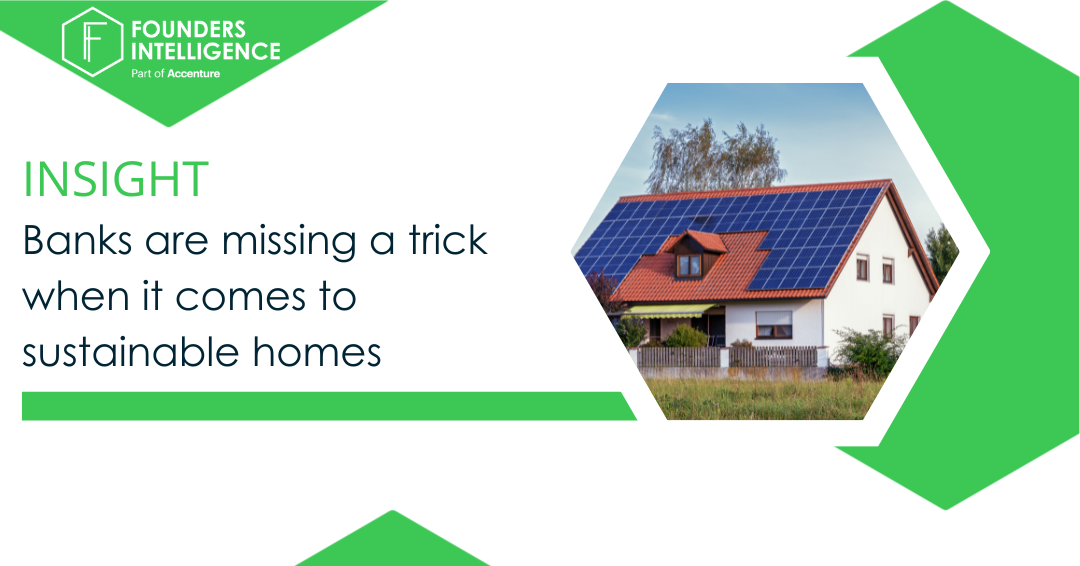Green mortgages are good… but they’re not great.
Green mortgages are good because they make energy-efficient homes more appealing. Unfortunately, they aren’t particularly suited to older properties that form the bulk of UK emissions and need significant retrofitting to become energy efficient.
This blog post presents three alternative propositions lenders could explore to promote sustainable homes to complement their green mortgage offering.
What are green mortgages?
For buyers looking to purchase a new home that has an Energy Performance Certificate (EPC) rating of A or B (that is, the most efficient on a scale of A to G), some lenders will offer mortgages at preferential pricing called green mortgages.
Recent studies show that 93%[1] of mortgage brokers expect an increase in green mortgage demand from today’s levels. On the face of it, it’s a win-win-win. Housebuilders are incentivised to build greener homes, lenders can allocate capital to more sustainable initiatives, and importantly, consumers get access to cheaper finance for making greener choices.
Why green mortgages in their current form fall short
While a good option for new-build homes, green mortgages in their current form do little to address emissions from the existing housing stock, which is responsible for more than 20%[2] of total UK emissions – that’s more than all the cars on the road today!
In essence, green mortgages are simply rewarding those who can already afford to buy greener homes, which are on average 14%[3] more expensive than older less energy-efficient homes.
To drive meaningful impact, financing solutions need to incentivise those unable to pay a premium to make their prospective/current homes more efficient. Considering 1.8 homes every minute will need to be retrofitted until 2050 to meet the UK’s net zero ambitions, this is a sizable opportunity to address.
Some lenders offer retrofitting incentives and cash-backs as part of their green mortgage offering. This means they’ll provide property buyers with a fixed sum ranging from £250 to £1.5k for renovations that improve the EPC rating of a property. However, given it costs ~ £6k[4] to improve the EPC rating of an average-sized mid-terrace property from D to the recommended minimum of C, the incentives on offer currently fall far too short.
Three example solutions to help incentivise retrofitting
Considering property values increase by around £15k[5] when their EPC ratings are improved from D to an A/B, buyers should seriously consider investing in retrofitting solutions given the returns when properties are eventually sold. For lenders, this enhances the risk profile of their loan given the increased value of the collateral (i.e. the property).
If lenders want to play a key part in enabling homeowners to reduce property-based emissions, they need to look beyond conventional asset-based lending models. This entails looking creatively and commercially at other sources of potential revenue that work towards the same goal – making green renovations more affordable.
Inspired by the innovation we are seeing in the venture ecosystem, here are three opportunities that lenders could explore to play a more impactful role in reducing home-based emissions:
1. Bundling Green Products & Services
Taking inspiration from other industries – such as telecoms providing Spotify subscriptions with monthly plans – lenders could offer mortgages that include a discounted heat pump to replace a gas boiler, as well as electricity for a period of time from a green energy supplier.
Commercially this is ambitious but doable, and a big win for all parties. Such partnerships are increasingly common in the green mobility space. Electric vehicle (EV) leasing ventures, such as London-based Elmo or OnTo, work with an ecosystem of commercial partners to offer their customers EVs and insurance with a single monthly plan, as well as discounted energy from green suppliers and even charging point installation.
The list of potential partnership areas for green homes is wide, from heat pumps to double-glazing and solar panels to roof insulation, so assessing the likely demand and commercial viability early on will be key to testing out new bundling propositions.
2. BNPL for the Sustainable Home Renovations
To stand out in an increasingly crowded consumer lending market while delivering on their sustainability ambitions, lenders could explore buy-now-pay-later (BNPL) solutions focused on upgrading green home credentials. Working with a pre-approved list of merchants to offer point-of-sale financing, lenders could offer their customers favourable credit terms in the seamless experience BNPL users have become accustomed to.
You don’t need to look further than Klarna’s partnership with Etsy.com or Afterpay’s collaboration with Houzz.com to see that home improvement is a mature category within the BNPL market. However, they offer unsecured lending for smaller ticket items such as furniture and are not sustainability or green-home focused. They certainly don’t improve the saleability of a property in the way more extensive home upgrades do.
There are also newer emerging BNPL players focused exclusively on home improvements, such as the Warwick-headquartered and Y-combinator graduate, Kanda, but those aren’t sustainability-focused either. Given the high cost of upgrading the energy efficiency of a home, there is also a greater credit risk to price in.
To ensure the risk/reward profile of the lending stacks up, it makes more sense for mortgage providers to be offering these solutions given they hold security over the property.
Furthermore, they would do so while maintaining a long-term relationship with borrowers spanning the term of the mortgage, which opens the window to a variety of methods to recoup credit or upsell services.
This brings us to the final opportunity…
3. Flexible Repayments for Green Home Upgrades
Mortgage affordability tests give mortgage providers an enviable view of their client’s income and monthly outgoings. Combined with open banking’s visibility of customers’ day-to-day spending, mortgage providers can make informed decisions about a borrower’s ability to pay for home improvements.
With that in mind, and leveraging some of the operational overheads banks already use to offer more flexible payments for offset mortgages, could lenders adjust the monthly mortgage payments? Or offer interest-free periods for homeowners who are upgrading their homes?
For example, fintech ventures such as Till in the US (which has raised over $10m in seed funding) offer renters flexibility by arranging a dedicated payment schedule to promote financial stability. They also offer short-term loans to help manage renter cashflows, helping both landlords and tenants. Though their model interfaces with residential landlords and renters, the underlying premise of assessing cashflows and adapting payments could be adapted to homeowners and their mortgage payments.
This flexible repayment model can be adapted to account for retrofitting outgoings early in the mortgage term. For example, by delaying mortgage interest payments until later in the fixed term portion of a mortgage while homebuyers are paying for insulation works on their loft.
For added security and to capture a larger share of clients’ banking wallets, this service can be made available to borrowers who divert their salaries to the bank itself, opening the door for further salary financing solutions.
So what’s next for lenders?
These illustrative opportunities will certainly require further exploration to ensure commercial viability, real customer demand and, of course, operational feasibility. They all involve a degree of risk. However, they all offer new potential revenue streams, on-sell opportunities and deeper touchpoints with borrowers.
Most importantly, all will contribute towards a more sustainable future by offering homebuyers financial incentives to improve the energy of their homes, making a dent in the single largest contributor to UK emissions.
To learn more about how we can help assess potential green lending initiatives in your innovation portfolio, rapidly test ideas in the market and set up the capabilities and governance structures you need to move at speed, get in touch with Jad Fadl.


